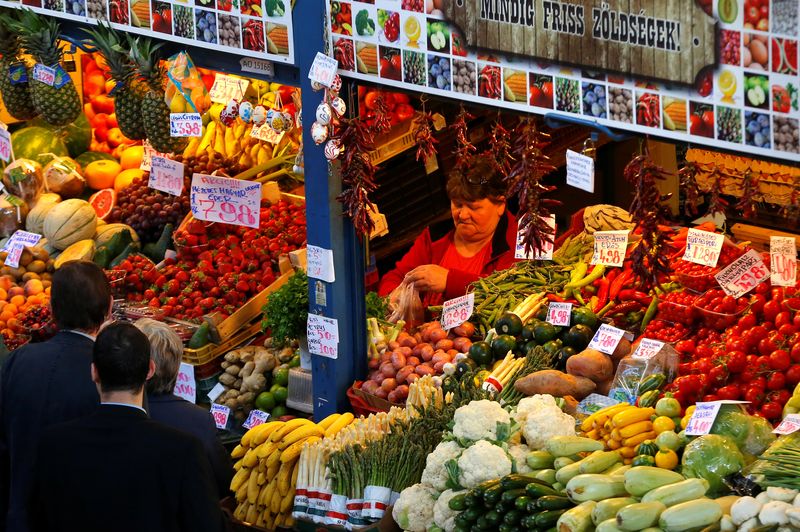By Gergely Szakacs and Anna Wlodarczak-Semczuk
BUDAPEST/WARSAW (Reuters) - While inflation in western Europe is largely expected to be tamed within a year, there is a growing sense that in central Europe runaway prices will be around for much longer.
Central and eastern Europe have for months been at the forefront of the inflation battle, ahead of the curve both in terms of the acceleration of price pressures and the sometimes uneven efforts of its central banks to curb them.
The latest inflation readings in the region ranged from nearly 16% in Romania to just over 20% in Hungary, way above central bank target bands ranging from 1% to 4%.
Hungarian bread and cheese prices rose by around 70% year-on-year in September while sugar prices in Poland have jumped 50% with some shops running low in the summer on hoarding in anticipation of more price rises.
With unions bargaining for strong wage hikes to retain purchasing power and companies hiking prices to protect profit margins, the risks are rising that a looming economic slowdown will not curb inflation to the extent central bankers hope.
"The longer inflation and wage pressures remain so strong, the greater is the risk that higher interest rates and sharp rises in unemployment are needed to weaken demand and restore price stability," Capital Economics' Emerging Europe Economist Nicholas Farr said.
The credibility of the region's central banks was tested last month when a plunge in the forint forced the National Bank of Hungary into an emergency rate rise weeks after it tried to end rate hikes with inflation still on the rise.
Poland's dovish majority in the central bank is also suggesting an end to rate hikes as growth is expected to slow strongly in 2023, but keeping inflation in check may be difficult with the government looking to spend ahead of a national election.
Inflation expectations are de-anchoring from central bank targets, UniCredit CEE Chief Economist Dan Bucsa said.
Bucsa pointed to front-loaded consumer spending in the first nine months of the year, which he said showed households expect inflation to rise further and wage bargaining resulting in much higher wage growth than in the past.
Hungarian household inflation expectations increased well into the double-digit territory based on the central bank's latest survey. Think tank GKI said price hike intentions rose across all sectors except for construction last month.
A Polish statistics office survey showed over 70% of consumers expected inflation to run at the same rate or even higher in the next 12 months, while think tank BIEC's survey showed an increase in both household and corporate inflation expectations.
PRICE PRESSURES
The economic fallout of the Ukraine war has exacerbated already strong inflation pressures due to tight labour markets, years of ultra-low borrowing costs and fiscal stimulus measures to boost economic growth.
In Hungary, Erzsebet Kristofi, a 47-year old single mother of a special needs child, has been relying for much of this year on charity.
"Everything has become more expensive, bread, basic foods ... cooking ingredients, everything," she said, as she queued for a hot meal on the outskirts of Budapest last week.
"That is why I come here, to have some fresh food every day and some bread, pastries or vegetables."
Government price controls have been in place in Hungary and Poland on some food, fuel and mortgages, taking effect at the end of last year and in early 2022.
In Hungary some price caps are due to expire at the end of the year but the government has signalled it would extend some of them as it has been doing over recent months.
The situation is less clear in Poland though credit holidays to ease the burden of higher central bank interest rates are remaining heading into 2023.
There is no sign the pressure on prices will ease soon.
LPP, Poland's biggest retailer, has said it plans to raise prices by 7% to 19% to compensate for rising costs and exchange rate effects.
Even with economic growth seen slowing to around 1%, Poland's main employers' association is projecting wage rises of 10% to 12% next year.
Hungarian companies are planning to raise wages by 9% in January on average, according to Sandor Baja, Managing Director of staffing company Randstad, and further rises could not be ruled out in some sectors later in the year.
POLAND'S PREDICAMENT
With the region's economies already slowing, the potential hit to growth prospects from more monetary tightening to tame inflation, and the upside inflation risks from surging producer prices, tight labour markets and exchange rate volatility have emerged as the core dilemma facing central bankers.
In western Europe, economists and financial markets largely expect price growth in the euro area to fall back to the European Central Bank's 2% target by 2024.
The outlook is very different for central Europe.
"Inflation expectations are very high and unanchored. This to me is the largest threat," said National Bank of Poland policy maker Joanna Tyrowicz, who is in a hawkish minority on the rate-setting panel.
"Unanchored expectations clearly separate Poland from the euro zone, where expectations respond kindly to the change of narrative by the ECB," she said.
Societe Generale (OTC:SCGLY) Lead CEEMA Strategist Marek Drimal expects Polish inflation to peak at above 20% in February and exceed 10% at least until end-2024. Hungarian inflation could reach 24% in February-April, easing to single digits in mid-2024, he said.
"Poland is in a more dangerous position, we believe," Drimal said. "The upcoming general election is likely to stimulate fiscal expansion and, notably, the planned significant increase to the minimum wage from January may indeed spark a more substantial wage growth across the board."

According to a Czech central bank survey, companies expect year-on-year inflation to be at 10.3% in one year and at 7.5% in three years, well above the central bank's 2% target.
Economists at Erste Group said inflation in the region could become a "persistent phenomenon."